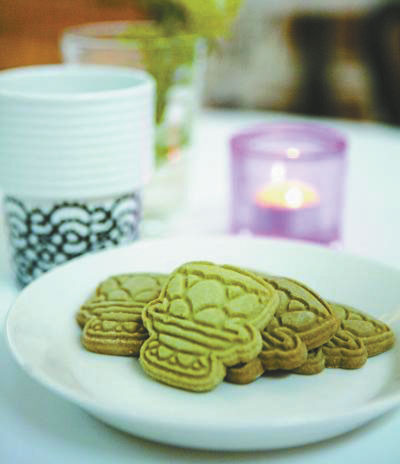|
WHAT kinds of products do most people expect to see and buy at a museum gift shop? For many people, most of the products sold at a museum are either serious or cute, and the most common selections may be bookmarks, atlases and notebooks.
However, Suzhou Museum in Jiangsu Province recently began offering something very different — “cultural relic cookies.”
The cookies, which were designed and launched by younger staff members, are now one of the most popular products sold at the museum. Many visitors, including those from areas outside Suzhou, come to the museum just for the cookies.
“They are so cute and beautiful that I don’t want to eat them,” said a university student surnamed Chen.
“Many museums work hard on their gift shops in order to attract visitors,” said Jiang Han, head of the cultural creativity department of the museum. “A successful gift shop can help increase a museum’s profit as well as the number of visitors.”
Museum employees came up with the idea while discussing snacks offered at the museum’s new book café. “We have always wanted to sell creative cultural products in the gift shop to attract visitors,” Jiang said. “When we were discussing what types of snacks we could offer at our new book café, we came up with the idea of ‘relic cookies’ because we wanted to offer something delicious and meaningful.”

When the idea was first proposed, many staff members doubted the feasibility of the plan. However, the managers were very supportive. “The younger staff members are very creative, so we wanted to let them have a crack at it,” said Mao Yan, deputy director of the museum. “I thought it was a great idea that would connect the museum to its visitors.”
Making the cookies was not an easy process, though.
“After numerous queries into the market and talking with cookie manufacturers, we finally decided to make some cookies in the shapes of the best exhibits at our museum,” Jiang said.
Eventually, the team decided to make a cookie shaped like a porcelain lotus bowl.
The bowl, which dates back to the Five Dynasties period (907-960), is one of the most precious relics at the museum. It was made with a special technique called miseci, which was popular in the Tang Dynasty (618-907), the Five Dynasties period and the Northern Song Dynasty (960-1127), that was only used by royal families.
“We thought about other sources to base the cookies on, such as the main museum building and other relics, but this was the ideal one as it is widely known by the public. Also, the bowl is green, so the cookie has a green tea flavor,” Jiang said.
Designing the cookie was also a challenge.
“It was much more complicated than we expected,” said Fu Ying-ying, a designer at the museum who designed the cookie. “Food is not the same as other products such as bookmarks or notebooks. They would be too fragile if the shape wasn’t right. Also, we thought that it should be cute to attract younger visitors.”
After three drafts, Fu finally came up with a satisfactory design. “The first version was not good. It did not look like a bowl at all. Some colleagues said that it looked like a leafy vegetable. But the final version was much better, it really looked like a side view of the bowl,” Fu said.
The cookies were officially introduced by the museum on its microblog May 18. “In the beginning, it was just a free gift. Later on, we started selling gift packages,” Jiang said. The gift package was sold online and at the museum June 18 for 25 yuan.
“They were so popular. A lot of visitors, mostly young visitors, traveled from other areas for them. Many netizens gave us suggestions on how to improve the cookies,” Jiang said.
In less than a month, the museum sold more than 500 boxes. The team next plans to offer more cookie selections in various flavors.
“I think items at museum gift shops should reflect local historical characteristics. For example, gifts at The Palace Museum in Beijing are stylish and magnificent. For museums like ours, we will focus more on offering elegant products at affordable prices,” said Mao.
(Wang Yuanyuan)
|

